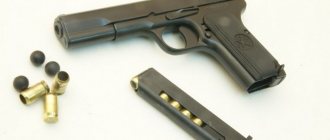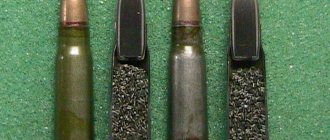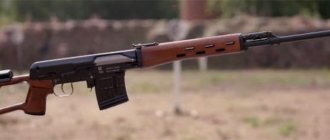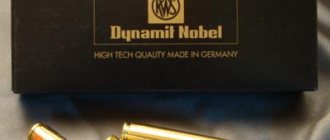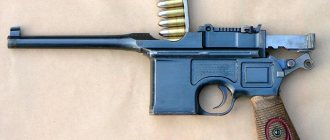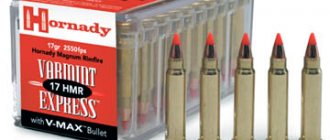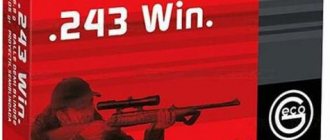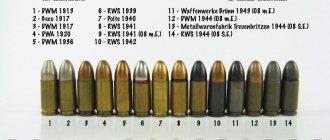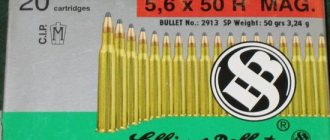Russian cartridges
Based on the experience of using small arms in the Second World War, the GAU Small Arms Directorate was tasked with creating a new pistol with significantly smaller mass-dimensional characteristics than the TT. At the same time, for the promising pistol complex, it was required to maintain the stopping effect of the bullet at the level of a 7.62 mm pistol cartridge, as well as to ensure high reliability and trouble-free operation in various operating conditions.
A new 9-mm pistol cartridge (9 P) with a case length of 18 mm was developed at NII-44 (later FSUE TsN I ITON MASH) and put into service together with the Makarov pistol in 1951. The bullet of the 9 P cartridge with a lead core, with almost the same mass as that of the TT, had a lower initial speed of more than 100 m/s and approximately 30% lower ballistic impulse. At the same time, the stopping effect of the bullet of the new cartridge was ensured by increasing its caliber and the spherical shape of the bullet head.
9x18 cartridges are designed for shooting from pistols and submachine guns. There are several modifications of the cartridge to ensure the performance of various tasks - with a bullet with a steel core, tracer, high-impulse, expansive, armor-piercing, etc.
9x18 cartridge with a steel core bullet 9 Pst (57-N-181S)
9x18 cartridge with a steel core bullet 9 Pst (57-N-181S)
The 9 Pet cartridge was developed to replace the 9 P cartridge with a lead core bullet in 1954. It is designed to engage living targets at a range of up to 50 m.
The bullet has a bimetal shell that completely covers the core. The shape of the bullet nose is spherical. The sleeve material is bimetal or steel coated with green varnish.
The bullet has no distinctive color.
9x18 cartridge with a 9 Pst steel core bullet in section
Bullet and steel core 9 Pst
Main characteristics of the 9 Pst cartridge
Cartridge mass, g: 10 Bullet mass, g: 6 Cartridge length, mm: 25 Initial bullet speed, m/s: 298 Firing accuracy at a distance of 25 m (R50), cm: 3.2
9x18 cartridge with increased penetration bullet RG 028
9x18 cartridge with increased penetration bullet RG 028
A high-pulse cartridge with a bullet of increased penetration was created in the late 1970s by order of the KGB of the USSR. It is designed to destroy living targets wearing personal armor protection.
Increased capabilities for penetrating body armor compared to the 9 Pet cartridge were achieved by improving the design of the core. The bullet is semi-shelled; this design was chosen to increase the penetration ability of the core, the energy of which is not spent on breaking through the shell.
The bullet has no distinctive color.
Main characteristics of the RG 028 cartridge
Cartridge mass, g: 11 Bullet mass, g: 6 Cartridge length, mm: 25 Initial bullet speed, m/s: 325 Firing accuracy at a distance of 25 m (R50), cm: 3.2
9x18 cartridge with increased penetration bullet 9 PP (7N16)
9x18 cartridge with increased penetration bullet 9 PP (7N16)
The high-impulse cartridge with a steel core bullet was created in the late 1980s. It is designed to engage living targets at a range of up to 50 m. Increased penetration and stopping power was achieved by significantly increasing the muzzle velocity.
The bullet weighing 5.5 g has a bimetal shell that completely covers the core. The shape of the bullet nose is conical. The 9 PP cartridge should only be used with the upgraded Makarov pistol (PMM)
The bullet has no distinctive color.
Main characteristics of the 9 PP cartridge
Cartridge mass, g: 9.6 Bullet mass, g: 5.5 Cartridge length, mm: 25 Initial bullet speed, m/s: 420
9x18 cartridge with a bullet of increased stopping power SP7
9x18 cartridge with a bullet of increased stopping power SP7
A cartridge with a bullet of increased stopping power is designed to destroy living targets unprotected by armor protection. Increased stopping power was achieved due to the design of the bullet and increasing its initial speed to 420 m/s.
The bullet is expansive, semi-sheathed with a cavity in the head.
The cartridge has been adopted by special law enforcement units. The head of the bullet is painted black.
SP7 and SP8 cartridge bullets
Main characteristics of the SP7 cartridge
Cartridge mass, g: 8 Bullet mass, g: 6 Cartridge length, mm: 25 Initial bullet speed, m/s: 420
9x18 cartridge with SP8 low-penetration bullet
9x18 cartridge with SP8 low-penetration bullet
A cartridge with a low-penetrating bullet is designed to destroy living targets when weapons are used in air transport by special law enforcement units. The requirement for low penetration is explained by the need to maintain the integrity of the aircraft fuselage when it is hit by a bullet.
The bullet is expansive, semi-sheathed with a cavity in the head. In order to reduce its penetrating power, the bullet speed was reduced to 250 m/s.
The head of the bullet is painted purple.
Main characteristics of the SP8 cartridge
Bullet mass, g: 5 Cartridge length, mm: 25 Initial bullet speed, m/s: 250 Firing accuracy at a distance of 25 m (R50), cm: 3.2
9x18 cartridge with armor-piercing bullet PBM (7N25)
9x18 cartridge with armor-piercing bullet PBM (7N25)
The PBM 9×18 cartridge was created at the State Unitary Enterprise "KBP" in the late 1990s. It is designed to destroy living targets wearing personal armor at a range of up to 50 m. Increased penetration and stopping power was achieved by reducing the mass of the bullet and significantly increasing (up to 480 m/s) its initial speed.
The bullet weighing 3.6 g has a high-strength steel core. The front part of the core protrudes from the shell.
The head of the bullet is painted black.
Armor-piercing bullet PBM
Main characteristics of the PBM cartridge
Cartridge mass, g: 7.4 Bullet mass, g: 3.55 Cartridge length, mm: 25 Initial bullet speed, m/s: 520
9x18 cartridge with PE expansive bullet
9x18 cartridge with PE expansive bullet
A cartridge with an expansive bullet was created for units of the Ministry of Internal Affairs in the late 1990s. It is designed to destroy unprotected living targets at a range of up to 50 m.
The bullet is expansive, semi-sheathed with a cavity in the head.
The bullet has no distinctive coloring.
Cartridge with an expansive PE bullet, top view
9x18 cartridge with PT tracer bullet
9x18 cartridge with PT tracer bullet
Cartridge with PT tracer bullet.
A cartridge with a tracer bullet was created for firing from submachine guns. It is designed to engage living targets, target designation and fire adjustment.
The head of the bullet is painted green.
PT tracer bullet
9x18 cartridge with a bullet with reduced ricocheting ability 9 PRS
9x18 cartridge with a bullet with reduced ricocheting ability 9 PRS
The PRS cartridge was created in the early 2000s by order of the Russian Ministry of Internal Affairs (9 PRS). The bullet core is lead. When hitting solid obstacles, such a bullet is crushed, quickly loses speed and does not produce dangerous ricochets.
The bullet does not have a distinctive color, but on the bottom of the cartridge case, along with the factory number and year of manufacture, there is a “PRS” stamp.
Bottom of cartridge case 9 PRS
Bullet with reduced ricocheting ability 9 PRS
9x18 training pistol cartridge 9 uch (57-N-181 uch)
9x18 training pistol cartridge 9 uch (57-N-181 uch)
The training pistol cartridge is intended for training in the techniques of loading and unloading weapons, firing a shot and loading magazines.
The training cartridge is manufactured using the main parts of a cartridge with an ordinary 9 Peta bullet, but does not contain a powder charge and has a cooled igniter primer. The cartridge is produced with a bimetallic sleeve.
Unlike live cartridges, its cartridge case has two annular grooves.
« back | menu | forward "
Soviet. Pistol cartridge 9 mm Makarow
The 9 mm Makarow pistol cartridge was developed in the Soviet Union after World War II as a live cartridge. After the fall of the Iron Curtain, Makarov pistols began to be increasingly supplied to the German market, so that 9 mm Makarow cartridges again became of great importance.
During World War II, the Soviet armed forces used the 7.62x25 Tokarew pistol cartridge, which was adopted along with the Tokarev TT-30 pistol, which was replaced by the TT-33 pistol in 1933 (the cartridge was adopted under the name "7.62 -mm pistol cartridge model 1930", the cartridge with a bullet with a lead core had the designation "P" and the GAU index 57-N-132; the pistol designed by F.V. Tokarev was adopted for service under the name "7.62-mm pistol model 1930", it is also called the TT pistol; in the process of launching mass production of the pistol, some changes were made to its design and the modernized pistol received the name "7.62 mm pistol model 1933", after which in 1933 mass production of TT pistols began. - Translator's note). The 7.62x25 cartridge, which was very similar to the German 7.63 Mauser cartridge, had a fairly flat bullet trajectory and high power, so it found use in submachine guns. Shortly after the end of World War II, the Soviet Army began to desire a pistol cartridge that would create a softer recoil, but still have a greater stopping effect, since submachine guns chambered for 7.62x25 due to the adoption of the Kalashnikov AK assault rifle to a large extent turned out to be unnecessary. In this case, a long range was not required. A competition for a new combat pistol, officially announced shortly after World War II, ultimately ended with the success of the Makarov pistol. The weapon developed by Nikolai Makarov (Nikolai Fedorovich Makarov, 1914–1988 - Translator's note) was based on the German Walther PP pistol and, like it, has simple automatics with blowback recoil, which allows the ballistic properties of the cartridge. Other technical features are a fixed barrel, around which the return spring is located, as well as a trigger mechanism that allows you to fire both self-cocking and with a pre-cocked hammer (DA-/SA-System). Disassembling a Makarov pistol is also similar to disassembling a Walther PP pistol, and, accordingly, PPK.
A suitable cartridge was developed by Boris Semin (Boris Vladimirovich Semin, 1911–1982 - Translator's note). At the same time, Semin had to take as a prototype the 9x18 cartridge, developed in 1936 by the Genschow company in Durlach. The development of the Genschow company, which did not leave the prototype stage, served as the prototype for the 9x18 Ultra (9 mm Police) pistol cartridge proposed in the 1970s. As in the case of the 9 mm Makarow cartridge (while retaining this original designation, which is also used by foreign ammunition manufacturers, we note that the cartridge was adopted for service in 1951 under the name “9 mm pistol cartridge”; depending on the type of bullet, it has the index GRAU, for example, with a bullet with a steel core 57-N-181S - Translator's note), and in the 9x18 Ultra cartridge they tried to surpass the ballistic properties of the 9 mm kurz cartridge and still use a blowback action in a light pistol.
Rare bullet diameter
For his 9 mm cartridge, in contrast to the much older and extremely popular 9 mm pistol cartridges 9 mm kurz, 9 mm Luger and 9 mm Steyr, Boris Semin assigned a larger bullet diameter. While the aforementioned Western cartridge designs used a bullet diameter of 0.355" (9.02 mm), the 9 mm Makarow cartridge was equipped with bullets with a diameter of 0.363" to 0.365" (9.22 mm to 9.27 mm). This factor sets up a bit of a headache for reloaders, as they cannot use the abundant .355 caliber bullets available.
The 9 mm Makarow cartridge, developed in the USSR after World War II, has a bullet diameter that is larger than conventional 9 mm cartridges. Source: PMC tables
Along with the Soviet Army, the 9 mm Makarow cartridge was adopted by almost all Warsaw Pact states. Various models of the Makarov pistol (adopted into service in 1951 under the name "9-mm Makarov pistol (PM), index GRAU 56-A-125 - Translator's note) were manufactured not only in the Soviet Union, but also in other eastern countries bloc, including in the then existing GDR. With the fall of the Iron Curtain by the early 1990s, more and more Makarov pistols began to reach Western Europe and the USA. This led Western cartridge and component manufacturers to adopt the 9 mm Makarow cartridge. From a weapons technology point of view, it is intended only for former Eastern Bloc pistols, which were developed for the 9 mm Makarow cartridge. These pistols are credited with two properties. Some praise the high reliability, which, however, others counter with modest shooting accuracy. It is often reported in specialized literature that, in terms of its ballistic properties, the 9 mm Makarow cartridge occupies a niche between the 9 mm kurz and 9 mm Luger cartridges. However, this is more wishful thinking than reality. If we look at the tables in cartridge catalogs, it turns out that the 9 mm Makarow cartridge is only minimally superior to the 9 mm kurz cartridge. For the 9 mm Makarow cartridge from Geco with a jacket bullet weighing 95 grains (6.2 g), the manufacturer calls V0 equal to 310 m/s, which ultimately gives E0 = 296 J. According to the Geco catalog, with the same bullet mass and the same with a barrel length of 150 mm, the initial bullet velocity of the 9 mm kurz cartridge reaches 300 m/s, while the muzzle energy is 277 J. In comparison, 9 mm Luger cartridges with a similar barrel length with heavier bullets sometimes have E0 values over 500 J.
Sufficient supply
Currently, among civilian products there is a significant variety of factory-made 9 mm Makarow cartridges. The cases are predominantly equipped with Boxer primers, which are well suited for reloading. The standard bullet weight for the 9 mm Makarow cartridge is 95 grains (6.2 g). Factory-loaded cartridges with a 95-grain (6.2 g) jacketed bullet are available from Geco, Sellier & Bellot, Fiocchi, and Winchester. The Serbian company PPU contributes its share with two cartridges. In one case we are talking about a version with a jacketed bullet weighing 93 grains (6.0 g), and in the other about a version with a semi-jacketed bullet with a cavity in the head, weighing 95 grains (6.2 g). Hornady offers a 95 grain (6.2 g) FTX bullet from its Critical Defense line.
The 9 mm Makarow cartridge is a cartridge with an almost cylindrical case without a protruding rim. According to the PMC tables, the difference between the values of dimensions P1 (9.95 mm) and H2 (9.91 mm) is only 0.04 mm. The 9 mm Luger cartridge uses a large taper. Like many pistol cartridges, the 9 mm Makarow is located in the chamber relative to the bolt mirror with the front end of the cartridge case, which inevitably prohibits its strong compression. Currently, a three-element set of dies from RCBS with a conical crimping die and a carbide calibration die costs 134.90 euros (Johannsen). You will also need a number 16 case holder from RCBS, which is also suitable for use with 9 mm Luger cartridges.
Guaranteed selection of components
Since not everyone uses factory-fired cases, Starline, Sellier & Bellot, PPU, and Hornady supply new factory cases designed to be loaded with Boxer primers. Thanks to the situation on the market with factory ammunition and new factory cartridges, fussing, as was usually the case before, with Berdan primer cartridges has become a thing of history.
The 9mm Makarow cartridge requires standard Small Pistol size primers. In the tests for this article, Federal 100 primers performed well. Alternatives include, for example, CCI 500, RWS 4031, Remington 1 1/2 and Winchester SP primers.
With regard to the powder charge, the choice is narrower; pistol powders from fast-burning to medium-burning are suitable. In our testing, decent results were achieved with Rottweil P 804, Alliant Bullseye and Alliant Unique powders.
The 9 mm Makarow cartridge was mainly distributed in the existing states of the Eastern bloc
As reported, when loading the 9 mm Makarow cartridge, purchasing bullets causes great difficulties, since they have a more than unusual bullet caliber from 0.363" to 0.365" (from 9.22 mm to 9.27 mm). There is a 95 grain (6.2 g) jacketed bullet with a diameter of 0.363" (9.22 mm) from the Czech cartridge manufacturer Sellier & Bellot.
The 0.364" (9.25 mm) diameter is specified for a Speer 95 grain (6.2 g) jacketed bullet. PPU reports a diameter of 0.3645" (9.26 mm) for both of its Makarow bullets. We are talking about a shell bullet weighing 93 grains (6.0 g) and a semi-jacket bullet with a cavity in the head weighing 95 grains (6.2 g). Hornady supplies the HP-/XTP bullet, which weighs 95 grains (6.2 g), which provides a good solution for defense purposes.
Bullet weights over 100 grains (6.5 g) for the 9 mm Makarow cartridge are prohibited due to the maximum cartridge length of 25.00 mm in accordance with the secondary gun size tables. Therefore, bullets for the 9 mm Makarow cartridge have a blunt or flat head. Due to the fact that Makarov pistols are available, 9 mm Makarow cartridges can mainly be reloaded by fans of standard combat pistols. Although, according to § 19 of the Federal Hunting Law, the 9 mm Makarow cartridge is approved for catching wounded animals, it is at the lower limit.
DWJ findings
The 9 mm Makarow cartridge is in the power class of the 9 mm kurz cartridges common in Germany. The main difference from other 9mm pistol cartridges is the bullet diameter. While cartridges such as the 9 mm Kurz, 9 mm Luger and 9x21 are equipped with bullets with a diameter of 0.355" (9.02 mm), the 9 mm Makarow cartridge has a bullet caliber from 0.363" to 0.365" (9.22 mm to 9. 27 mm). This deviation creates a headache for reloaders, since there are very few such pistol bullets on the market. The bullet weight for the 9 mm Makarow cartridge is limited from above to approximately 100 grains (6.5 g). This is due to the volume of the sleeve and the maximum length of the cartridge.
Hans J. Heigel, translation by Nikolai Yezhov
Encyclopedia of weapons
Cartridge 9x19 Luger / Parabellum, 1902, Germany
Tactical and technical characteristics of 9 mm Luger / Parabellum
Caliber - 9×19 Luger Real bullet caliber, mm - 9.03 Length, mm - 29.69 Case length, mm - 19.15 Case flange diameter, mm - 9.96 Base diameter case, mm - 9.93 Case neck diameter, mm - 9.65 Bullet leading part diameter, mm - 9.03 Bullet weight, g - 4.08-9.53 Powder charge weight, g - 0.46-0, 48 Weight of the cartridge case with primer, g - 3.54-3.60 Initial bullet speed, m/s - 310-600 Maximum pressure of powder gases, kg/cm2 - 1300-2800 Muzzle energy of the bullet, J - 380-710
The cartridge was developed in 1902 by Georg Johann Luger to increase the power of the Parabellum pistol. In 1904 it was adopted by the German Navy, and in 1908 by the German Army. Initially, the bullet had a conical shape with a flat head (in the form of a truncated cone).
Cartridge 9×19 early release
In 1904, to increase the power of the Parabellum pistol, Luger changed the shape of the 7.65 mm cartridge case from bottle to cylindrical, connecting it to a 9 mm cartridge bullet.
Cartridge 9×19
Initially, the 9x19 cartridge had a jacketed bullet with a flat head (in the form of a truncated cone). In 1915 it was replaced by a bullet with an ogive head. The bullet initially had a nickel silver-clad steel shell with a lead core. Since 1917, the steel bullet casing has been varnished with tombac.
9x19 Luger: FMJ; FMJ nick; HP (RP); HP (CBC); HP nick (from left to right)
The 9×19 cartridge cases are available in both brass and copper-plated steel. The bullet can be of any type, including plastic. General purpose bullet - jacketed with a lead core. The shell is bimetallic or steel, clad with tombac.
Cartridges produced for civilian and police weapons were equipped with almost all types of bullets produced in the world.
The good ballistic properties of the 9x19 cartridge made it the standard ammunition for pistols and submachine guns in most countries of the world after World War II.
The 9x19 Luger / Parabellum cartridge is produced in almost all countries of the world. 9x19 Luger from various manufacturers
In principle, the clarification of the type 9x19 “Parabellum” or 9x19 “Luger” only gives an idea of the geometric dimensions of the sleeve. There is no identity between these designations: in some countries the first abbreviation refers to military cartridges, and the second to cartridges for the civilian market, while in Finland the first abbreviation refers to cartridges with cartridges with a Berdan-type capsule socket, the second to a Boxer-type capsule socket "(the successor to the Berdanov capsule, which almost replaced the Berdanov capsule).
Some European companies still use the designation 9x19mm "Luger" for cartridges supplied to the American market, while for other purchasing countries the same cartridges are sold as 9x19 "Parabellum".
However, the external geometric dimensions of the cartridge case, identical within tolerance, unite thousands of the most diverse cartridges in the 9x19 caliber family, developed in all corners of the world since 1902.
9x19 cartridges have several basic modifications that differ in power: 9-mm “parabellum” with a standard impulse (i.e. the pressure in the barrel bore does not exceed the norm), the so-called “standard” cartridge, 9-mm +P (i.e. pressure in the barrel bore is high (increased)), 9 mm +P+ (i.e. the pressure in the barrel bore is very high - this type of cartridge is used by the police, less often in “civilian” pistols), 9 mm NATO (used by armies NATO countries).
There are also so-called “automatic” 9x19 cartridges intended for submachine guns, which in the West have the general designation “series B 3” (The use of such cartridges in any pistols is unacceptable, because due to much more, even compared to the 9x19-mm cartridge "NATO" maximum permissible pressure of powder gases can rupture the barrel. They can only be used in submachine guns).
Modern weapons, such as, for example, pistols “Glock-17”, “Beretta-92 FS”, etc., are produced taking into account the fact that 9-mm +P+ or 9 mm cartridges will probably be used for shooting -mm NATO.
True, experts do not advise owners of such pistols as, for example, Glock-17, Beretta-92 FS, etc., to always shoot with 9-mm +P+ or 9-mm NATO cartridges; it is better to shoot with a “standard” cartridge 9x19, since in the case of firing with a “standard” 9x19 cartridge, the barrel life will be much higher than in the case of firing with 9x19 +P, 9x19 +P+ or 9x19 NATO cartridges.
It is also worth mentioning the fact that Russia also switched to the “European standard”, accepting the 9x19 caliber cartridge (and its modifications) as one of the standard cartridges for military weapons (and also due to the fact that the 9x18 PM cartridge turned out to be powerless against modern means of personal armor protection ) at the Tula Cartridge Plant they developed its improved modification - the 9x19 PP cartridge.
9x19 PP (GRAU Index - 7N30) - a cartridge with a bullet of increased penetration. Developed in the late 2000s. KBAL named after. L.N. Koshkina together with the Tula Cartridge Plant. Bullet weight is 5.5-5.8 grams at a pressure in the barrel bore of up to 2200 atm. (220 mPa), the initial bullet speed is 420-445 m/s at a distance of 10 meters from the muzzle, which corresponds to a kinetic energy of 714 J. This energy is enough to penetrate a 7-mm steel plate, and a 4-mm plate made of St.3 steel at a distance of 60 m, body armor Zh-86-2 at a distance of 25 m. True, only early 9x19 PP cartridges had such acceptable pressure.
Armor-piercing cartridge 9×19 (7H21)
9x19 PST (GRAU Index - 7N21) - a cartridge with a bullet with a steel core. Developed by TsNIITochmash in the early 1990s. Bullet weight - 5.4 grams, initial bullet speed - 445-470 m/s. It is superior in power to commercial 9x19mm Parabellum ammunition and equal to the more powerful military 9x19mm NATO (9x19 +P) cartridges. The bullet penetrates a 4 mm plate of St.3 steel at a distance of 55 m.
However, later, the working pressure of serial armor-piercing cartridges 7N21 (developed by TsNIITOCHMash, cartridge designer - I.P. Kasyanov) was seriously increased, which turned out to be higher than that of 9x19 caliber cartridges, designed for use only in submachine guns.
Armor-piercing cartridge 9×19 PBP (7N31)
9x19 PBP (GRAU Index - 7N31) - a cartridge with a bullet of increased penetration. Developed by the Tula Instrument Engineering Design Bureau in the early 2000s. The semi-jacketed bullet of the 9×19 PBP cartridge has a heat-strengthened steel core, bare at the head. The shirt is made of aluminum alloy. Bullet weight - 4.1 grams, initial bullet speed - up to 600 m/s. The high speed and design features of the bullet ensure reliable penetration of body armor of the 2nd protection class according to GOST R50744-95. When used in combination with a new cartridge with increased penetration (7N31), it ensures penetration of class 3 body armor or 8 mm steel plate at a distance of at least 20 m.
The later 7N31 cartridge (developed by KBP) has even more “strict” levels of maximum permissible pressure, even compared to the 7N21 cartridge, which leads not only to unnecessary loads on the weapon, but also does not make it possible to achieve acceptable accuracy and accuracy of fire.
It is also worth noting that Russian ammunition manufacturers produce the 9x19 Luger cartridge with “standard” operating pressure with both brass, steel and bimetallic cases.
It should also be noted that the cartridges produced by the Tula TPZ have external sealing of the bullet and an increased (compared to other Russian cartridge factories) thickness of the varnish layer at the barrel of the case.
9x19 P (GRAU Index - 7N35) - cartridge with a bullet with a lead core. Developed by TsNIITochmash, not mass-produced.
9x19 T (GRAU Index - 7T4) - cartridge with a tracer bullet. Developed by TsNIITochmash, not mass-produced.
9x19 PRS is a cartridge with reduced ricochet ability. Developed and mass-produced by Barnaul Machine Tool Plant OJSC. Bullet weight - 7.47 grams, initial bullet speed - 345-385 m/s.
9x19 PSO - sports cartridge. Serially produced by the Tula Cartridge Plant. Bullet weight - 7.46 grams, initial bullet speed - 340 m/s.
